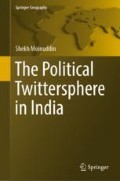Abstract
Social media has generated a broader set of implications across the world and set a new predicament for communication dialogue and involvement. Here, we examine, measure, and predict the likely changes in day-to-day political communication among politicians through social media particularly Twitter, between voters and politicians, has shaped the political discourse in spatio-temporal dimensions and to what extent has it been revolutionized.
Access this chapter
Tax calculation will be finalised at checkout
Purchases are for personal use only
Notes
- 1.
Liberalization policy (1991) made many changes and reduced digital gaps wherein role technological developments, economic policy shaped the communication industry in India.
- 2.
Gainous and Wagner (2014, p. 4).
- 3.
For more, see https://www.ndtv.com/india-news/pranab-mukherjees-rss-date-today-as-daughter-tweets-resentment-1863683, last accessed June 7, 2018.
References
Converse PE (1962) Information flow and the stability of partisan attitudes. Public Opin Q 26(4):578–599
Gainous J, Wagner KM (2014) Tweeting to power: the social media revolution in American politics. Oxford University Press, NewYork
Graber DA (2010) Processing politics: learning from television in the internet age. University of Chicago Press, Chicago
Kernell S (1994) Going public: new strategies of presidential leadership, 4th edn. CQ Press, Washington, DC
Kinder DR (2003) Communication and politics in the age of information. In: Huddy L, Jervis R, Sears DO (eds) Oxford handbook of political psychology. Oxford University Press, New York, pp 357–393
Poster M (1995) The second media age. Polity, London
Prior M (2005) News vs Entertainment: how increasing media choice widens gaps in political knowledge and turnout. Am J Polit Sci 49(3):577–592
Prior M (2007) Post-broadcast democracy: how media choice increases inequality in political involvement and polarize election. Cambridge University Press, New York
Sommers PM (2002) Is presidential greatness related to height?. Coll Math J 33(1):14–16
Author information
Authors and Affiliations
Corresponding author
Rights and permissions
Copyright information
© 2019 Springer Nature Switzerland AG
About this chapter
Cite this chapter
Moinuddin, S. (2019). Digital Political Revolution in India. In: The Political Twittersphere in India. Springer Geography. Springer, Cham. https://doi.org/10.1007/978-3-030-11602-6_5
Download citation
DOI: https://doi.org/10.1007/978-3-030-11602-6_5
Published:
Publisher Name: Springer, Cham
Print ISBN: 978-3-030-11601-9
Online ISBN: 978-3-030-11602-6
eBook Packages: Earth and Environmental ScienceEarth and Environmental Science (R0)

